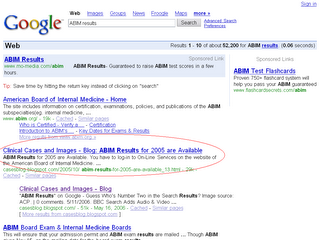 Big Mama Doc
Big Mama Doc writes a funny and deeply-insightful blog about working at her family medicine practice, teaching residents and having not the best of health herself.
According to her blog, she had a stroke not a long time ago but was able to return to work with the help of several medications including Coumadin.
Unfortunately, while at a conference in San Francisco at the beginning of May, she had a series of new strokes and had to be hospitalized for surgical interventions:
5/2/06
Update"I was admitted Friday night with several new strokes. Turns out my bad mood was nothing but poor perfusion; a few intracranial stents this afternoon should do the trick. Please forgive the brevity of this message. Typing is a challenge with limited use of my left hand."
5/3/06
SagaBy a Friend of Big Mama Doc: "The procedure last night terminated early once they saw how goopy things were in those brain arteries "
5/5/06
One Down One To GoBy "Big Mama's not so talented writer husband": "Bigmama had her procedure yesterday afternoon. It lasted almost eight hours."
5/10/06
Part Two"Mama Doc had her second procedure."
5/14/06
Home"Quite frankly, I'm amazed to still be alive, and I am lucky to have limited deficit. Typing is a challenge, but speech is better every day."
5/15/06
What I RememberShe is now discharged home and on the path of recovery surrounded by her loving family. It takes courage to write about you personal problems and to share you deepest fears with the world.
I wish her a speedy recovery.
Follow-up5/26/06
Occupational TherapyThe road to recovery after a stroke in not an easy one, especially for practicing physicians. There are so many fine motor skills that we take for granted which have to be "re-mastered" after a stroke.
FatDoctor has a long list for her occupational therapist...
References:
Anniversary: My Story in Ten Brief Chapters. Fat Doctor.
Blogiversary. Fat Doctor.
Image source:
FatDoctor.blogspot.com
 ClinicalCases.org was redesigned to give credit to the authors and to streamline the front page of the website, so that it reflects the natural flow of a clinical encounter:
ClinicalCases.org was redesigned to give credit to the authors and to streamline the front page of the website, so that it reflects the natural flow of a clinical encounter:













